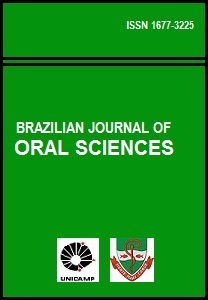Abstract
Aim: To investigate the effect of the cooling rate on flexural strength of monolayer and bilayer porcelain/zirconia (Y-TZP) bars. Methods: Forty-five specimens were made for each design group: (PM) monolithic specimens of veneer porcelain Vita VM9 (Vita, Germany); (ZM) monolithic specimens of zirconia (ZiHP; ProtMat, Brazil); (PB) bilayer specimens zirconia/porcelain with porcelain on lower surface; and (ZB) bilayer specimens porcelain/zirconia with zirconia on lower surface. Each group was cooled by three different methods after porcelain sintering: slow – specimens were cooled inside the turned-off furnace; normal – specimens were removed from the furnace and cooled in air at room temperature; and fast – specimens were removed from the furnace at 910°C and cooled by compressed air for 10 s. Specimens were polished and flexural strength was measured in water at 37 °C (n=15). Maximum load at fracture was recorded, and equations for simple (monolayer) and composite (bilayer) structures were used to calculate the flexural strength. Results were analyzed using one-way ANOVA (p<0.05) and Tukey test separately for each design. Results: The results of one-way ANOVA were statistically significant only for the PB group. The post-hoc Tukey test showed the highest flexural strength for fast cooling and the lowest for slow cooling; the normal cooling was statistically similar to both. Conclusions: Cooling methods affected only the flexural strength of bilayer specimens with porcelain on low surface (under tension) when the slow cooling method was used.
This work is licensed under a Creative Commons Attribution 4.0 International License.
Copyright (c) 2015 Antonio Alves de Almeida-Júnior, Diogo Longhini, Beatriz Regalado Galvão, Claudinei dos Santos, Gelson Luis Adabo
Downloads
Download data is not yet available.

